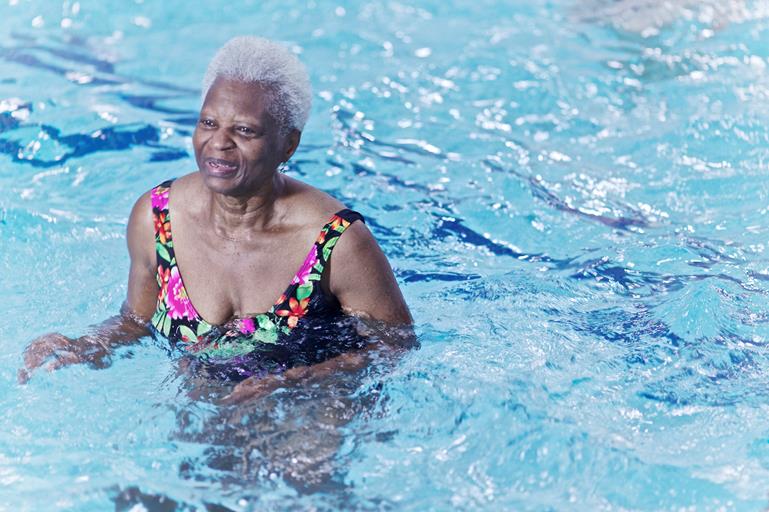Delivering physical activity as a health intervention via exercise referral programmes in leisure centres, community venues and green spaces is potentially very cost-effective, providing over £20,000 of social value per person using the HM Treasury-endorsed WELLBY, and £5,600 worth of health improvements using the NHS QALY.
The independent study was commissioned to economists, State of Life (named advisors on the 2021 HM Treasury Green Book supplementary guidance on wellbeing for appraisal) and who provide robust evidence on the social value of physical activity using Treasury-endorsed methods. This study builds on State of Life’s work on a new model of social value for Sport England.

A survey dataset of over 3,000 respondents across eight Greater Manchester localities contributed to the study.
Around 2,000 were current or previous participants in the programmes, taking exercise prescribed by a healthcare professional or self-referred. A further 1,000 were awaiting the start of the programme, providing an essential control group and enabling a high standard of evidence.
The findings revealed that taking part in the programme is associated with significant improvements in personal and mental wellbeing, community cohesion, individual development, physical health, and reduced reliance on NHS services.
One notable highlight includes a 1.32-point difference in life satisfaction between participants and those on the waiting list, which is almost three times greater than the improvement seen in the national data when moving someone from unemployed to employed[1].
[1] Green Book Supplementary guidance on wellbeing for appraisal, pg. 41
The biggest boosts to life satisfaction were seen among those with a lower baseline wellbeing, such as being physically inactive, having a disability or a long-term health condition, or those living in more deprived communities. Specifically, it was found that the greatest wellbeing gains came from those who participated at least 4-6 times a week, attended supervised sessions, attended specialist classes and stayed in the programme for at least 4-6 weeks. The report also shows that benefits were still high among people who started in a programme up to two years ago.
Wellbeing value is up to eight times higher when working with those participating in exercise referral schemes compared to the average adult.
Using HM Treasury-approved wellbeing valuation methods, this converts into a social value of £21,800 per person per year.
As a comparison, through State of Life’s work with Sport England, they found that a member of the general population being physically active is worth £2,500 of social value. Participation in a GM Active programme is, therefore, worth eight times more, highlighting the expertise the collective organisations have in supporting those with the most health benefits to gain.
State of Life, who analysed the survey’s 3,181 responses gathered over two waves of data collection, says: “The NHS’ 10-year strategy sets out to ʻdeliver health outcomes in non-NHS settingsʼ. This study makes a very good case for just how to get started.
“What’s more, 80% of participants say they plan to stay physically active (after finishing a programme), and 66% say they intend to continue as ‘customers’ at their GM Active centre. This suggests many participants transition from being funded referrals to self-sustaining members, contributing directly to the financial viability of the service providers.”
The survey also included the EQ-5D-5L questionnaire to measure health-related quality of life. The EQ-5D index was used to calculate QALYs (Quality-adjusted Life Years), a standard used by NICE and the NHS to assess whether health interventions, including drugs and services, offer good value for public money.
Findings suggest that participation in GM Active’s exercise referral programmes is associated with an average health improvement equivalent to £5,600 per person in QALY terms.
Based on a conservative NHS production cost benchmark of £15,000 per QALY, this implies the programmes would represent value for money if delivered at a cost under £1,200 per participant per year – early estimates in the GM Active study suggest the costs could be less than a quarter of this figure. Exactly what Wes Streeting wants to hear.
Participants also reported 19% fewer GP appointments over a 28-day period compared to those on the waiting list, suggesting that these programmes not only improve health-related quality of life but also reduce pressure on frontline NHS services.
Long term, it is likely this reduction is the tip of the iceberg for NHS savings – and looking at a longitudinal study of these sorts of inventions at a national scale is almost certainly worthwhile.
These findings make the compelling case for expanding and embedding exercise referral as a critical component in the shift from treatment to prevention. They also support GM’s wider ambition to create a population health system that reduces inequality, boosts wellbeing, and reduces pressure on public services.
Andy King, Chair of GM Active, said “The results of this study are significant. We were determined to properly understand the effect that physical activity could have when used as an intervention to improve a person’s health and well-being. We were prepared to be disappointed with the results – that’s the risk we took – but we were confident that physical activity really is medicine.The impact upon people’s lives is clear; at a time when central government is looking for transformational changes in its approach to health services and across Greater Manchester and the UK there is unequivocal commitment to the Live Well initiative, this study gives ample evidence of the role that physical activity can play.”
For further enquiries, contact Nigel Wareing, Cornerstone DM: 07834 835922
Cornerstone DM is a GM Active Strategic Business Partner